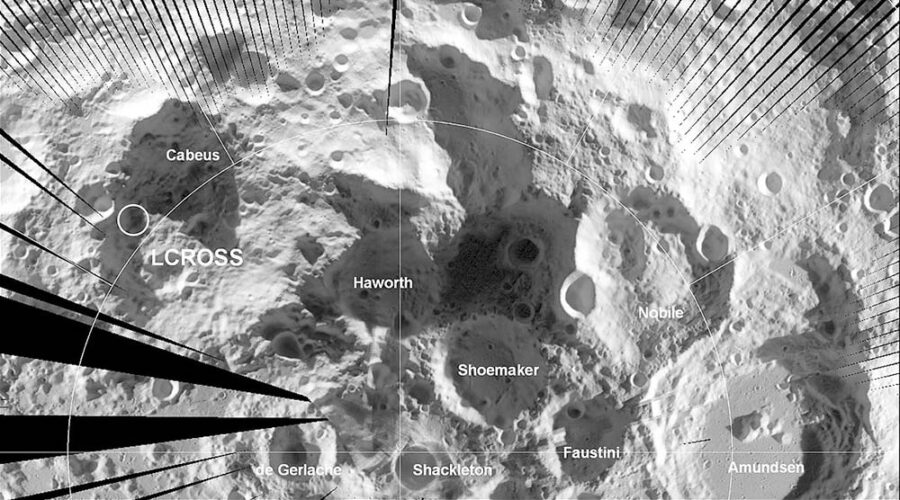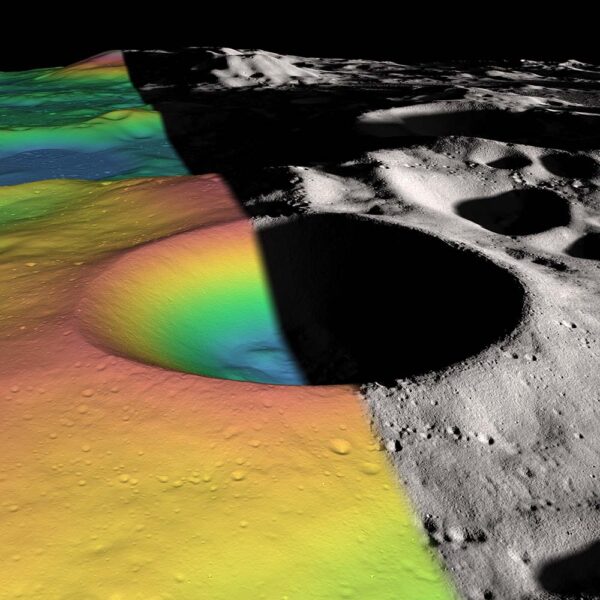5.03.2022
SHACKLETON CRATER VITALS
| Official name | Shackleton Crater |
| Location | 89.90°S 0.00°E |
| Diameter | 21 kilometers (13 miles |
| Depth | 4 km (2.6 mi) |
Later this year, NASA plans to land a robotic drilling machine on the Moon called the Polar Resources Ice Mining Experiment 1, or PRIME 1. The landing site: a crater named Shackleton, located almost exactly at the Moon’s south pole.

This isn’t the first time Shackleton Crater has been the focus of exploration. In addition to the new drilling mission, Shackleton Crater has been examined from orbit by NASA’s Lunar Orbiter 4, Clementine, Lunar Prospector, and Lunar Reconnaissance Orbiter. Japan’s SELENE and India’s Chandrayaan 1 orbiters also investigated the crater. All in all, Shackleton Crater has been probed by cameras, zapped with radar, sniffed by sensors, and even physically smashed by an impactor — all in a sustained scientific effort to learn its secrets.
But why? With the Moon home to millions upon millions of craters, ranging in size from enormous (Imbrium Basin, into which lava flowed to make Mare Imbrium) to tiny (micrometeorite pits on rocks), why should Shackleton be singled out for all this attention? The answer is multifaceted but comes down to two important features: permanent light and permanent darkness. Both attributes may have implications for future human exploration — and NASA has seriously considered the area around Shackleton Crater as a possible landing site for the future human landings that are a goal of its Artemis program.

NASA
UNIQUE LIGHTING
If you’ve ever visited the far northern or southern regions of Earth, you understand firsthand the unique lighting conditions the polar regions entertain during certain parts of the year. For example, locations above the Arctic Circle experience 24-hour sunlight during the summer and 24-hour darkness in the winter, with the situation is reversed in the south. High latitudes and the seasonal effects of Earth’s 23.5° axial tilt are responsible for these extremes.
The situation on the Moon is somewhat different. Since the Moon’s axial tilt is only 1.5°, seasonal changes are minimal. This means that peaks at the lunar poles can experience almost constant daylight, while pits may never see the Sun at all, remaining in continual shade.
Shackleton Crater offers both these extremes in one place: Portions of the crater rim remain in almost year-round sunlight, while the crater floor is permanently dark.
ICE IN THE SHADOW
So why is permanent darkness on the Moon so important? In a word: ice. The Moon is a place with essentially no atmosphere and no liquid water, so visiting astronauts must bring all of their consumables along — a heavy and therefore expensive undertaking.
But unmanned spacecraft have provided good evidence for ice deposits within Shackleton’s shadowed interior — preserved from evaporation by the extraordinarily low temperatures there. From a human-exploration standpoint, significant amounts of lunar ice represent several benefits:
- Oxygen to breathe. A rather simple electrically powered chemical reaction called electrolysis can separate a water molecule (H2O) into oxygen and hydrogen gases. By collecting ice, melting it, and extracting the oxygen molecules, astronauts could conceivably make their own air.
- Fuel. Conversely, astronauts could use the hydrogen atoms released during electrolysis as a fuel source, as rocket propellant or just transportation around the lunar surface.
- Water to drink. Sure, it seems strange to think about, but if lunar ice is present in easily accessible quantities, future astronauts could melt it for basic human needs such as drinking, cooking, and washing.
SUNLIGHT FOR POWER

NASA / GSFC / Arizona State University
Sunlight is also important for the electricity it can provide. Space exploration requires electrical energy, and while we can bring that energy from Earth, generating it in situ using solar panels (as on the International Space Station) is preferable.
- Constant power. At Shackleton Crater, a crew of human explorers would have a fantastic opportunity to harvest continual sunlight, converting the Sun’s energy into electricity around the clock. Establishing the initial infrastructure might present a challenge, but once built solar panels placed along the rim of Shackleton Crater would easily generate electricity for a growing lunar base. Solar panels in this situation would be even more effective than those on Earth, thanks to a permanently clear lunar sky.
- Light. Regions near the Moon’s equator experience lengthy “days” and “nights” — each about 14 Earth days long. This wasn’t a problem for the Apollo astronauts, who spent a maximum of 75 hours on the surface and could time their visits accordingly. Future astronauts staying for extended time periods can avoid contending with long lunar nights if they build their base at a location like Shackleton.
PHYSICAL PROPERTIES
Exploring Shackleton Crater would be a dramatic experience because of its sheer size and magnificence. Apollo astronauts certainly explored some amazing terrain, like Hadley Rille and the slopes of Cone Crater. Shackleton would surely offer an even more stunning view.
Doug Cooke, former deputy associate administrator for NASA’s Exploration Systems Mission Directorate, said, "The south pole of the moon certainly would be a beautiful place to explore. We now know the south pole has peaks as high as Mt. McKinley and crater floors two and a half times deeper than the Grand Canyon.”
Shackleton is unusually deep for its size, extending 4 km down and 21 km across. It’s a cone-shaped crater, with walls that slope at about 30°, truncated at the bottom by a level floor. Its central peak stands about 200 meters (650 feet) tall. While smaller craters puncture Shackleton’s walls, they are otherwise fairly flat. It would be quite an undertaking for astronauts to explore the crater interior, searching for ice on a dark slope.

NASA / Zuber, M.T. et al. / Nature 2012
Inferring the presence of ice in this crater from orbit has been something of an art as well as a science, and scientists have interpreted the results in different ways. That’s part of the reason NASA is sending PRIME 1 to the surface — to drill directly into the lunar regolith and perform a specific inspection into the nature of the ice that’s there. Is ice accessible in its raw form? Or is it chemically mixed in minerals? Exploring Shackleton Crater offers the opportunity to obtain “ground truth.”
THE MAN BEHIND THE NAME
Lunar craters are typically named for real people — especially those with substantial contributions to science or exploration. Shackleton Crater is no exception. Both the crater’s name and location pay tribute to Sir Ernest Shackleton (1874–1922). Shackleton participated in four voyages to the Antarctic region, including one that reached the south magnetic pole. But it was his 1914 voyage in particular that cemented his legacy to this day.
That expedition featured an attempt to cross the Antarctic continent on foot. With a crew of 28, Shackleton approached the mainland with a ship aptly named the Endurance, but drifting ice surrounded the ship and it eventually sank. The men spent months camping on the frozen ocean until finally escaping the ice in three salvaged lifeboats to tiny Elephant Island near the Antarctic Peninsula. Shackleton then set sail with a crew of five in what was then the largest lifeboat, sailing for help across 800 miles through storms and bitter cold. Upon reaching civilization, Shackleton immediately arranged for the rescue of the party still waiting on Elephant Island, and the entire crew was ultimately saved.
Like Apollo 13, Shackleton’s expedition can be seen as a “successful failure,” and his leadership skills certainly contributed to the successful outcome. The diaries of Shackleton’s crew often reflect an optimistic outlook, even exhibiting a dose of humor at times. Shackleton is remembered as an impeccable leader; it’s no surprise that his name was chosen for a crater at the Moon’s south pole.
HOW TO SEE SHACKLETON CRATER
As exciting as future human exploration of Shackleton Crater might be, you don’t have to wait — or be an astronaut! — to explore the crater yourself. Indeed, viewing Shackleton Crater with your backyard telescope is possible, but it’s a real challenge due to the crater’s extreme southern location.

Wikipedia
You can never look straight down into Shackleton the way you can with Tycho or Copernicus. But with a favorable southern libration, in which the Moon tilts slightly to reveal more of its southern pole, you can see the sunlit edge of Shackleton surrounded by a sea of rugged terrain (including craters named for other Antarctic explorers). Librations that reveal the Moon’s southern latitudes happen every month, but you may need to time your observation to a specific advantageous phase. Check Sky & Telescope, which lists favorable lunar librations every month.
Pinpointing exactly which crater is which can be difficult when all of them appear oblique, so photographing the scene through your scope’s eyepiece and making your identification at leisure may be helpful. You can also explore the crater up close through the eyes of the Lunar Reconnaissance Orbiter.
If you are lucky enough to glimpse the crater’s rim, take a moment and imagine how, someday, not that far away, someone else may be standing there looking back at you.
Quelle: Sky&Telescope
